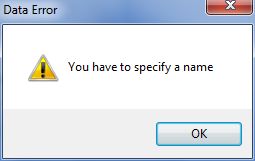
The individual fields of the data base are described below. Please be aware that certain fields are mandatory and must be filled – an error message is displayed if such a field has not been filled.

|
Bandwidth [Hz] |
Enter the required receiver bandwidth for this signal. |
|
Baud Rate [Bd] or Symbol Rate [Bd] |
Enter the channel rate in Bd. For two-condition signals, e.g., FSK, PSK-2 or CW, the baud rate equals the bit rate including channel coding overhead if any. For two-condition signals without any overhead, the baud rate equals the user or source bit rate. |
|
Codecheck Count |
The number of times the code check must be executed to obtain the desired confidence level. |
|
Comments |
A user free text field. |
|
Decoder |
Enter the WAVECOM decoder mode used by the CCC. Selected from a drop-down list of available modes. |
|
Name |
The name given to the table entry by the user. This field is a free text field. |
|
Modulation |
The modulation method used by the decoder. Set by default or selected from a drop-down list of modulation methods available for the selected decoder. |
|
ITU Designator |
A user free text field for the ITU emission designator applicable to this signal. |
|
Minimum No. of Carriers |
The minimum number of carriers in a multi-carrier system. |
|
Minimum No. of Channels |
The minimum number of channels in a VFT system. |
|
Minimum No. of Tones |
The minimum number of tones in a multi-frequency system. |
|
No. of Carriers |
The number of carriers in a multi-carrier system. |
|
No. of Channels |
Number of channels in a VFT system. |
|
No. of Tones |
The number of tones in a multi-frequency system. |
|
Pilot Frequency [Hz] |
If applicable, the frequency of the system pilot frequency, pilot tone or Doppler correction tone. |
|
Recognition disabled |
If checked the signal is not included in the CCC recognition process and the record is greyed out in the list of records. |
|
Shift [Hz] |
The frequency shift for two-frequency FSK. |
|
Spacing [Hz] |
The frequency spacing between adjacent tones in a multi-frequency system (do not confuse up “Spacing” and “Shift”). For multicarrier systems Spacing is user editable by clicking Edit, which will open the Multicarrier Signal window, see below. If equal spacing is desired press Same spacing for all carriers and enter the spacing in the entry field and press OK to save.
If Multiple spacings are desired press the Multiple spacings radio button and select a Carrier-Spacing pair from the list:
Enter the desired spacing and press OK to save the value. |
|
Submode |
The modulation format of the subcarriers of this OFDM system. |
|
Tone Duration [ms] |
In MFSK systems the duration of a tone, i.e., the inverse of the system baud rate. |